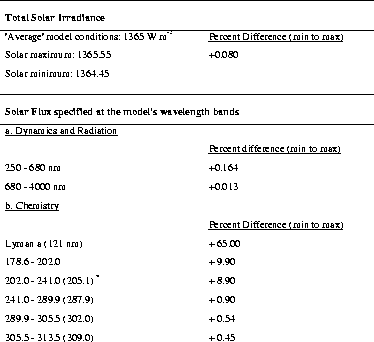Our experiment aims at investigating the effects of enhanced solar UV radiation on climate. For this purpose, 2 separate runs of the model are being performed, lasting for 20 model years. The first model run represents conditions prevailing at the state of maximum solar activity during the sun's 11-year cycle, with enhanced solar irradiance mainly at the UV intervals, while the second run represents minimum solar activity conditions.
The basic state of the model, an 'average' state of the 11-year solar cycle, is a simulation of the present-day atmosphere, representing a time-slice for 1990, with carbon dioxide concentration set to 353 ppmv and chemical boundary conditions for 1990. The Sea Surface Temperature (SST) is fixed in the model, representing a 1974 -1994 climatology. The runs are performed from re-start files from a 60-year model run.
The solar fluxes in both perturbation runs were adjusted in the model's spectral intervals according to the difference between the solar minimum and solar maximum spectral solar flux changes (Lean et al., 1997). The changes are summarised in Table 1. Maximum solar activity is represented by enhanced solar flux distributed within the radiation scheme spectral intervals and enhanced solar flux distributed at the wavelength bands used for the photolysis rate calculations.
